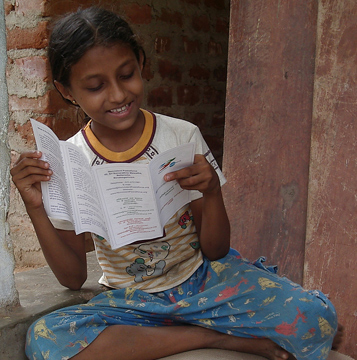The Power of the Adolescent Girl: Vision for 2030
On December 19, 2011, the United Nations General Assembly adopted
Resolution 66/170 to declare 11 October as the International Day of the
Girl Child, to recognize girls' rights and the unique challenges girls
face around the world.
|

Sri Lanka girl with NPSL Brochure. Pic -
www.nonviolentpeaceforce.org |
This year, as the international community assesses progress under the
Millennium Development Goals (MDGs) since their implementation in 2000
and sets goals to be achieved by 2030, girls born at the turn of the
millennium have reached adolescence, and the generation of girls born
this year will be adolescents in 2030. As we reflect on the achievements
of the past 15 years and plan sustainable development goals for the next
15, it is an opportune time to consider the importance of social,
economic, and political investment in the power of adolescent girls as
fundamental to breaking the intergenerational transmission of poverty,
violence, exclusion and discrimination and to achieving equitable and
sustainable development outcomes.
Adolescent girls have the right to a safe, educated, and healthy
life, not only during these critical formative years, but also as they
mature into women. If effectively supported during the adolescent years,
girls have the potential to change the world - both as the empowered
girls of today and as tomorrow's workers, mothers, entrepreneurs,
mentors, household heads, and political leaders. An investment in
realising the power of adolescent girls upholds their rights today and
promises a more equitable and prosperous future, one in which half of
humanity is an equal partner in solving the problems of climate change,
political conflict, economic growth, disease prevention, and global
sustainability.
Over the past 15 years, the global community has made significant
progress in improving the lives of girls during early childhood. In
2015, girls in the first decade of life are more likely to enrol in
primary school, receive key vaccinations, and are less likely to suffer
from health and nutrition problems than were previous generations.
However, there has been insufficient investment in addressing the
challenges girls face when they enter the second decade of their lives.
This includes obtaining quality secondary and higher education, avoiding
child marriage, receiving information and services related to puberty
and reproductive health, and protecting themselves against unwanted
pregnancy, sexually transmitted disease and gender-based violence.
As the global community launches the Sustainable Development Goals (SDGs)
for implementation over the next 15 years, it is a good time to
recognise the achievements made in supporting young girls, while at the
same time aspiring to support the current and upcoming generation of
adolescent girls, to truly fulfil their potential as key actors in
achieving a sustainable and equitable world. In recognition of the
importance of investing in adolescent girls' empowerment and rights,
both today and in the future, the theme of International Day of the Girl
Child for 2015 is: The Power of the Adolescent Girl: Vision for 2030.
UN agencies, Member States, civil society organizations, and private
sector stakeholders are called on to commit to putting adolescent girls
at the centre of sustainable development efforts by making the following
critical investments in their present and future:
• Invest in high quality education, skills, training, access to
technology and other learning initiatives that prepare girls for life,
jobs, and lead ership.
• Invest in health and nutrition suitable to the adolescent years,
includ ing puberty education, menstrual hygiene management, and sexual
and reproductive health education and services.
• Promote zero tolerance against physical, mental, and sexual
violence.
• Enact and consistently implement social, economic, and policy mech
anisms to combat early marriage and female genital mutilation.
• Invest in the creation and maintenance of social and public spaces
for civic and political engagement, creativity and talent enhancement.
• Promote gender-responsive legislation and policies across all areas
especially for adolescent girls who are disabled, vulnerable and mar
ginalized, and victims of trafficking and sexual exploitation.
The commitment by the global community to realising the potential of
adolescent girls will directly translate into the girls as powerful and
positive change agents for their own empowerment, for advancing gender
equality and for the sustainable advancement of their nations.
-UN.org
|

